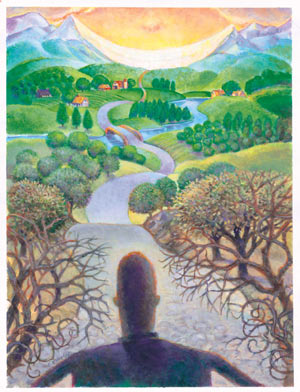Illustrations by Ernie Eldredge
Here’s a brain-teaser to get started: If you have half as much fun reading this story as we’ve had writing it, does that make us twice as happy—or you 50 percent less content? Is there a difference? And just what do we mean by “happy” anyway?
 These are the kinds of questions that drive the fledgling science known as positive psychology. Two hundred and thirty years after Thomas Jefferson first declared that Americans had a right to the “pursuit of happiness,” a new breed of psychologist is trying to figure out why it’s so hard to catch. They see themselves as emotional naturalists, stalking the elusive butterfly of happiness in hopes of pinning it down to the examining table of science.
These are the kinds of questions that drive the fledgling science known as positive psychology. Two hundred and thirty years after Thomas Jefferson first declared that Americans had a right to the “pursuit of happiness,” a new breed of psychologist is trying to figure out why it’s so hard to catch. They see themselves as emotional naturalists, stalking the elusive butterfly of happiness in hopes of pinning it down to the examining table of science.
In doing so they have struck a popular chord. The field’s founding father, Martin Seligman, a psychology professor at the University of Pennsylvania, has written several bestsellers. Last spring, Harvard’s class on positive psychology became the most popular course on campus. Magazines across the country (present company included) have put the subject on their covers. And as we will see, interest in positive psychology techniques has reached the highest levels of government in at least one major nation.
Happiness research knows no boundaries, and that means it’s a perfect fit for UAB, which has always prided itself on being an “institution without walls.” Sure enough, the university has several faculty collaborating in the new scientific search for contentment—and a new course in positive psychology began this spring.
Of course, the quest for happiness doesn’t require a Ph.D., just a pulse. We canvassed the campus in search of experts in both the science and the art of good cheer, and found them among alumni and students, faculty and staff. From psychology to physical education, medicine to music, join us for an enlightening walk down the sunny streets and dark alleys of our favorite mood.